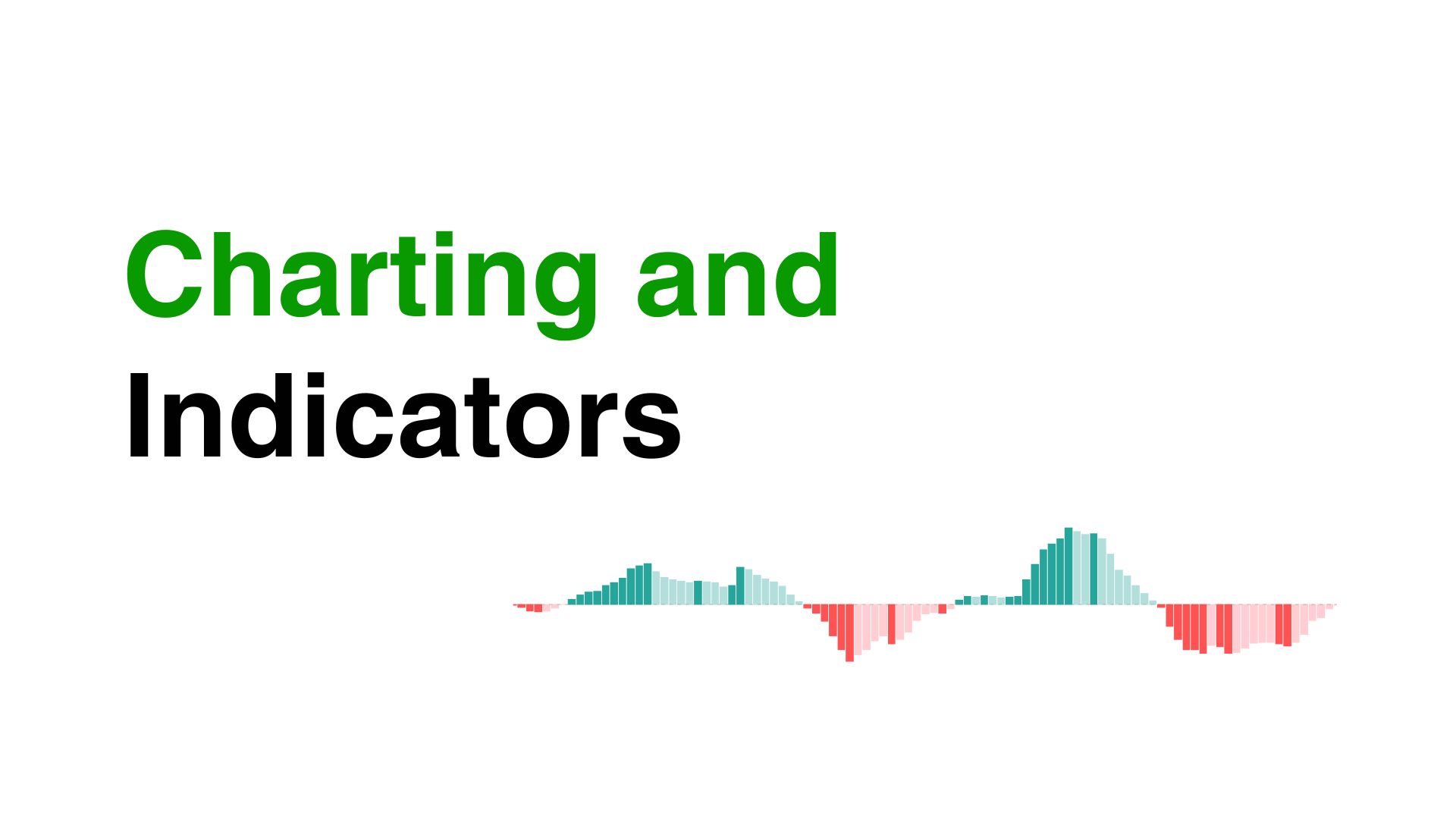Chapter 4: Charting and Indicators
Trading I Premium

Learning Tip
In this chapter we will learn about different charting patterns and trading indicators which are used by traders for making trading decisions as well as entry and exit setups.
Section 4.1
Introduction to Charting
Purpose of Charting
- Charts visually represent price movements of financial instruments over time, making it easier to analyze trends and patterns.
- They help traders identify entry and exit points, as well as potential reversals or continuations in price movement.
Types of Charts
Line Charts
- Display only the closing prices over a specified time period, connected by a continuous line.
- Useful for identifying general trends but lack detail about price movements within the period.
Bar Charts
- Show the open, high, low, and close (OHLC) prices for a specific time period.
- Each bar represents the price movement over that period, providing more information than line charts.
Candlestick Charts
- Similar to bar charts, but visually more informative, with each “candlestick” showing the open, high, low, and close prices.
- The body of the candle indicates whether the price closed higher (bullish) or lower (bearish) than it opened, and the wicks show the high and low prices.
- Patterns formed by candlesticks (e.g., Doji, Hammer, Engulfing) can signal potential reversals.
Section 4.2
Understanding Trends
Definition of Market Trends
- Trends refer to the general direction in which a market or asset price is moving over time.
Types of Trends
Uptrend
- Characterized by a series of higher highs and higher lows. Indicates bullish market sentiment.
- Identified by connecting the lows on a chart to form a trend line.
Downtrend
- Characterized by lower highs and lower lows. Indicates bearish market sentiment.
- Identified by connecting the highs on a chart.
Sideways/Range-Bound
- Occurs when prices move within a defined range without a clear upward or downward trend.
- Traders often use range strategies to capitalize on price oscillations within the range.
Section 4.3
Support and Resistance
Definition of Support and Resistance
- Support: A price level where buying interest is strong enough to overcome selling pressure, preventing the price from falling further.
- Resistance: A price level where selling interest is strong enough to overcome buying pressure, preventing the price from rising further.
Identifying Support and Resistance Levels
- Historical price levels where the asset has reversed direction in the past.
- Psychological levels, such as round numbers (e.g., $50, $100).
- Using trend lines and horizontal lines to mark potential support and resistance zones.
Role Reversal
- Once a support level is broken, it may turn into resistance, and vice versa. Understanding this concept helps traders anticipate potential price movements.
Section 4.4
Indicators and Their Uses
Definition of Technical Indicators
- Mathematical calculations based on price and/or volume data that help traders analyze market trends and potential reversals.
Categories of Indicators
Trend Indicators
- Help identify the direction of the market trend.
- Examples:
- Moving Averages (MA): Smooth out price data to identify the trend direction. Common types include Simple Moving Average (SMA) and Exponential Moving Average (EMA).
- Average Directional Index (ADX): Measures the strength of a trend without indicating direction.
Momentum Indicators
- Indicate the strength of price movements and potential reversals.
- Examples:
- Relative Strength Index (RSI): Measures the speed and change of price movements, indicating overbought or oversold conditions (values above 70 indicate overbought; below 30 indicate oversold).
- Stochastic Oscillator: Compares a security’s closing price to its price range over a specific period, identifying potential reversal points.
Volume Indicators
- Analyze the strength of price movements based on trading volume.
- Examples:
- On-Balance Volume (OBV): Uses volume flow to predict changes in stock price, showing whether volume is supporting price movements.
- Accumulation/Distribution Line: Measures the cumulative flow of volume, helping identify whether a stock is being accumulated (bought) or distributed (sold).
Section 4.5
Charting Patterns
Definition of Chart Patterns
- Visual formations created by the price movements of an asset on a chart, often signaling potential future price movements.
Common Chart Patterns
Head and Shoulders
- A reversal pattern that can indicate a trend reversal. Consists of a peak (head) between two smaller peaks (shoulders).
Double Tops and Bottoms
- Double Top: A bearish reversal pattern formed after an uptrend, characterized by two peaks at roughly the same price level.
- Double Bottom: A bullish reversal pattern formed after a downtrend, characterized by two troughs at roughly the same price level.
Triangles (Ascending, Descending, Symmetrical)
- Patterns that indicate consolidation before a potential breakout. The price compresses within converging trend lines.
Flags and Pennants
- Short-term continuation patterns that form after a strong price movement, indicating a brief consolidation before the previous trend resumes.
Section 4.6
Combining Indicators and Chart Patterns
Importance of Combining Analysis Techniques
- Using multiple indicators and patterns can confirm signals and improve the accuracy of trading decisions.
Example Strategy
- A trader might look for a bullish candlestick pattern at a support level, confirmed by an RSI below 30 (indicating oversold conditions) and an increasing volume pattern. This convergence of signals may provide a stronger case for entering a long position.
Final Takes
Conclusion
Recap of Key Points
- Charting is essential for visualizing price movements and understanding market trends.
- Support and resistance levels are critical for determining entry and exit points.
- Technical indicators and chart patterns enhance analysis and decision-making in trading.
Looking Ahead
- The next chapter will focus on risk management and trading psychology, which are crucial for executing strategies effectively and maintaining discipline.

